
Macro Dynamics of the Bitcoin Halving – a brief overview

The Bitcoin halving is a much-anticipated event within the crypto industry and had historically signaled profound shifts in the market dynamics of Bitcoin (BTC). The halving, which is projected to occur on April 22, 2024, will create a supply side shock and contraction, and could substantially and sustainably alter Bitcoin's price and miner economics.
With Bitcoin operating on a disinflationary model and a hard total supply cap, the upcoming halving block reward reduction from 6.25 BTC to 3.125 BTC will further constrain the supply of new bitcoins entering the market. Given Bitcoin’s sustained trend of long-term adoption, following the exponential logarithmic growth curve of network adoption, the fundamental dynamics for Bitcoin’s price trajectory are evident. Furthermore, Bitcoin halving cycles coincided and aligned closely with overall liquidity cycles and their respective expansions and contractions.
Taking a broad macro view at the price implications and dynamics of past Bitcoin halvings, we will examine the return on investment (ROI) dynamics of previous halving cycles. The chart depicts the trends of each respective halving cycle leading to a significant increase in Bitcoin's value over the following years. The first halving in November 2012 saw an approximate 100x increase from the halving price, the second in July 2016 about a 30x increase, and the third in May 2020 approximately an 8x increase.
The observed dynamics suggest a pattern of diminishing returns with each successive halving, with the peak halving cycle ROIs being remarkably close to 1/3rd of the prior cycle ROI. This aligns with both our general long-term trend models and dynamics we analyzed in the Crypto & Macro series, as well as the general disinflationary nature of Bitcoin’s rewards decreasing over time. For the upcoming fourth halving, prior cycle dynamics could suggest a potential 3x ROI from the halving price, which is a more conservative projection that considers the maturing market and simultaneous increased adoption of Bitcoin. This is a trend of lengthening cycles and diminishing returns.

With markets being relatively inelastic and inflexible to react to supply side shocks, it is a possibility that this halving could also serve as a catalyst for market activity and long-term price appreciation. A notable observation from past halving dynamics is, however, that markets tend to rally into the halving, in anticipation, with the halving itself showing almost no price action. The interim weeks following the halving, markets tended to stay flat, with slight selling in the short-term. We were able to observe these dynamics almost analogously throughout the most recent Bitcoin ETF approval.
Overall, the halving has the potential to be a significant long-term catalyst for BTC’s price trajectory, next to the macroeconomic environment, adoption, and other factors, and is likely a much-anticipated event that carries significant historical weight.